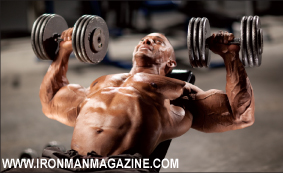 This month I address another popular chest exercise, the incline press. As you know, the incline press is typically performed with a bar, dumbbells or a Smith machine. What you may not know is that the exercise is a bit unique with regard to injuries and development.
This month I address another popular chest exercise, the incline press. As you know, the incline press is typically performed with a bar, dumbbells or a Smith machine. What you may not know is that the exercise is a bit unique with regard to injuries and development.
Many incline benches are fixed at a certain angle, usually somewhere between 45 and 60 degrees. Adjustable free benches can usually be moved from 20 to 90 degrees and are usually used for dumbbell inclines and Smith-machine inclines.
There is an unusual relationship between the incline press and the bench press. Trainees appear to be divided into two groups: those who can bench-press without pain but have pain when they do the incline press and those who have tremendous shoulder pain when bench pressing yet can incline-press pain free. No one knows why, but we see it in the gym routinely. There are a few theories about treating the pain and about the modifications of the incline press that may work or may only work for a while.
Trainees often give up the incline barbell press due to shoulder pain. The typical alternative is dumbbell inclines performed on an adjustable bench, which provides two ways to find less pain. One is that you can turn the dumbbells away from the fixed barbell position and find a more comfortable position. A new problem can arise when you turn your wrists so that the palms face each other because that allows you to lower the dumbbells beyond your chest.
Some will say that’s a good stretch and will bring better muscle growth. There is some truth to that, but other factors are at play. The extreme stretch and range of motion can stress the labrum, a cartilage ring that surrounds the shoulder socket, and contribute to a tear of the labrum or aggravate an existing tear. Labral tears can make the shoulder very painful during incline presses, bench presses, flyes and even pushups. Those who have pushed their shoulder stretch and range of motion for many years may have overstretched the ligaments in the front of the shoulder, which creates shoulder instability. The various bench press motions will hurt the shoulder if the ligaments are overstretched.
What are the solutions for incline-press-related shoulder pain? The first is to try the dumbbell incline press, as noted above. Be very careful of how low you bring the dumbbells. Either let your palms face each other and don’t let the dumbbells put a maximum stretch on your pecs, or keep the dumbbells in the same position as a bar so they hit your chest and prevent excessive shoulder stretch. One of those variations may help reduce the shoulder pain and keep you pressing.
The other solution is to use an adjustable bench. Some trainees will find that a more subtle angle, such as 30 degrees, can stop all of the pain. Others may find 60 degrees or more to be tolerable. If you try using dumbbells with different hand positions and combine that with various angles on the incline bench, you will most likely find a way to keep performing the incline press.
As with any lift, there are always those who seem to excel no matter what problems others may have. Great incline performers of the past include strongmen Steve Merjanian and David Paul, who had max incline presses of 500 pounds. Legendary bodybuilder Casey Viator also performed that weight. A 181-pound class powerlifter, Pat Neve, performed an incline of 410 pounds, and I’ve seen a 198-pound Olympic weightlifter perform a 390-pound 80 degree incline press.
Train smart, then train hard.
Editor’s note: Visit www.SoftTissueCenter.com for reprints of Horrigan’s past Sportsmedicine columns that have appeared in IRON MAN. You can order the books, Strength, Conditioning and Injury Prevention for Hockey by Joseph Horrigan, D.C., and E.J. “Doc” Kreis, D.A., and the 7-Minute Rotator Cuff Solution by Horrigan and Jerry Robinson from Home Gym Warehouse, (800) 447-0008 or at www.Home-Gym.com.




















You must be logged in to post a comment Login